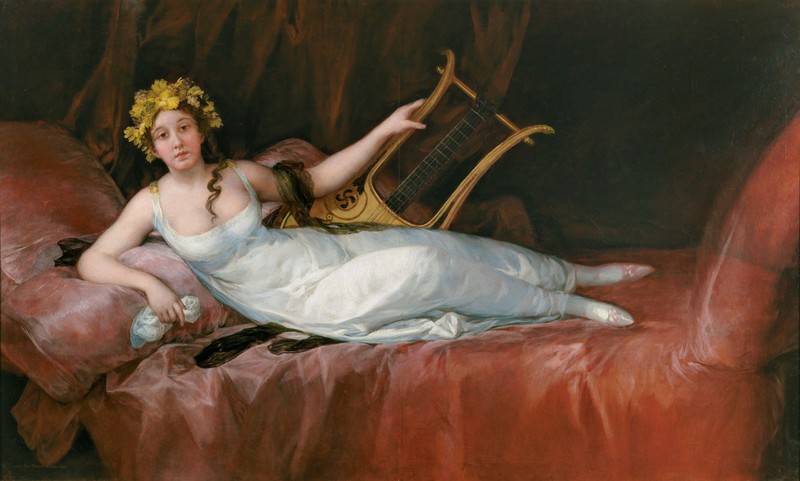- Cronología
- 1805
- Ubicación
- The Prado National Museum. Madrid, Madrid, Spain
- Dimensiones
- 124 x 207 cm
- Técnica y soporte
- Oil on canvas
- Reconocimiento de la autoría de Goya
- Documented work
- Titular
- El Prado National Museum
- Ficha: realización/revisión
- 21 Mar 2010 / 16 Jun 2023
- Inventario
- (P07070)
D.a Joaquina Giron Marquesa de Santa Cruz / Por Goya 1805 ("Doña Joaquina Girón, Marchioness of Santa Cruz, By Goya, 1805", lower left-hand corner).
This work belonged to the heirs of the Marchioness of Santa Cruz. It was later owned by the Count of Pie de Concha, son of the Marquises of Santa Cruz. In 1941 it became the property of a Bilbao-based collector, Félix Fernández Valdés. It was acquired by the Spanish state in 1986 with the help of different organizations in order to go to the Prado Museum.
Doña Joaquina Téllez-Girón y Pimentel (Madrid, 1784-1851) was the daughter of the Duke and Duchess of Osuna and was married to Don José Gabriel de Silva y Waldstein, 10th Marquis of Santa Cruz and the first director of the Prado Museum.
Goya had already painted the marchioness, with her parents and siblings, in 1788, when she was just a girl. In this later portrait, considered one of the artist's most sensual, Doña Joaquina was twenty-one years old. She is represented in the guise of a muse of lyrical poetry, in reference to her artistic interests, which she had cultivated since she was a child. She received a careful upbringing from her parents, who opened up their home to the most brilliant musicians, men and women of letters and artists of the time. Goya presents her here reclining on a divan upholstered in red velvet. She is wearing a white dress with straps and a high empire-line waist, with a low-cut neckline and red shoes. Her hair is decorated with a crown of leaves and fruit, alluding to the allegorical nature of this representation. In her right hand she holds a white handkerchief, whilst her left hand rests upon a lyre, a fashionable instrument in late 18th-century Europe, a reference to the sitter's passion for music. We can see on the lyre a four-armed cross, the symbol of the Santa Cruz family.
The face of the sitter, who was considered by her contemporaries to be one of the most beautiful women of her time, looks sensually out at the viewer, emanating serenity, tenderness, elegance and intelligence.
According to some writers, the overall effect of the portrait is very reminiscent of the work of Velázquez, particularly in the way the white of the dress contrasts with the red of the divan on which the figure rests. The folds of the fabric of the sofa are especially well executed, possessing a strong sense of realism.
It is believed that Goya may have taken his inspiration for this work from other portraits. Beruete states that the harmony of colours reminds him of Velázquez's The Toilet of Venus, and Sánchez Cantón compares it to the Majas, by Goya himself, and Titian's Venus of Urbino.
There exists another version of this painting (Los Angeles County Museum) but it is not accepted as an original by Goya.
-
Pinturas de GoyaMuseo Nacional del PradoMadrid1928consultant editor Fernando Álvarez de Sotomayor. From Apri to -May 1928cat. 68
-
cat. 59
-
Goya y el espíritu de la IlustraciónMuseo Nacional del PradoMadrid1988from October 6th to December 18th 1988. Exhibited also at Museum of Fine Arts, Boston, January 18th to March 26th 1989; The Metropolitan Museum of Art, Nueva York, May 9th to July 16th 1989, Madrid curator Manuela B. Mena Marqués, scientific directors Alfonso E. Pérez Sánchez and Eleanor A. Sayrecat. 66
-
Realidad e imagen. Goya 1746 – 1828Museo de ZaragozaZaragoza1996consultant editor Federico Torralba Soriano. From October 3th to December 1st 1996cat. 51
-
Goya. 250 AniversarioMuseo Nacional del PradoMadrid1996consultant editor Juan J. Luna. From March 29th to June 2nd 1996cat. 125
-
Goya. La imagen de la mujerMuseo Nacional del PradoMadrid2001from October 30th 2001 to February 10th 2002. Exhibitied also at the National Gallery of Art, Washington, March 10th to June 2nd 2002, consultant editor Francisco Calvo Serrallercat. 37
-
Goya: Prophet der ModerneAlte NationalgalerieBerlin2005from July 13th to October 3th 2005. Exhibitied also at the Kunsthistorischemuseum, Vienna, October 18th 2005 to January 8th 2006, consultant editor Manuela B. Mena Marquéscat. 86
-
Goya en tiempos de guerraMuseo Nacional del PradoMadrid2008consultant editor Manuela B. Mena Marqués, from April 14th to July 13th 2008cat. 37
-
Goya: The PortraitsLondon2015cat. 36
-
L'œuvre peint de Goya. 4 volsParís1928-1950p. 154, cat. 441
-
Vie et ouvre de Francisco de GoyaParísOffice du livre1970p. 199, cat. 828
-
BarcelonaPolígrafa1970vol. I, p. 328, cat. 496
-
Francisco de Goya, 4 vols.ZaragozaCaja de Ahorros de Zaragoza, Aragón y Rioja1980-1982vol. III, p. 150
-
Goya y el espíritu de la IlustraciónMadridMuseo del Prado1988pp. 258 y 259 (il.), cat. 66
-
Goya. 250 AniversarioMadridMuseo del Prado1996pp. 125 (il.), 396 y 397, cat. 37
-
Realidad e imagen. Goya 1746 – 1828MadridGobierno de Aragón y Electa España1996pp. 152 y 153 (il.), cat. 51
-
Goya, la imagen de la mujerMadridMuseo Nacional del Prado y Fundación Amigos del Museo del Prado2001pp. 192 y 193 (il.)
-
Goya en tiempos de guerraMadridMuseo Nacional del Prado2008pp. 208 y 209 (il.), cat. 37
-
Goya en Madrid. Cartones para tapices 1775-1794MadridMuseo Nacional del Prado2014p. 194
-
LondonNational Gallery Company2015pp. 132-133
-
www.museodelprado.es, consulted 22-03-1022-03-10
